Elgin Deanery
Auldearn
Parish Church: OS Ref: NGR NH 920556 H.E.S. No: NH95NW 6.01 Dedication: St Columba (Colm)
Associated Chapels: Achareidh {NGR NH 868564}; Easter Clune {NGR NH 956515}; Foynesfield {NGR NH 892538}; Geddes {NGR NH 888528}; Kincraggie {NGR NJ 910534}; Lethen {NGR NH 93_51_}; Lochloy {NGR NH 9235 5798}; Moyness Castle {NGR NH 951538};Nairn - Holy Rood (Invererne) {NGR NH 885566}; Rait Castle {NGR NH 893525}.
St Columba is associated with Auldearn. However, it is possible that he, himself, never visited Auldearn and that the church was first established by clerics from Iona. An alternative dedication is to St Colm but churches associated with the Iona familia are often, mistakenly, refered to as St Colm's. The great antiquity of this site is, though, well established and without question.
One immediate result of the defeat of Domnall Meic Uilleim (Donald MacWilliam) at the Battle of Mam Garvia, in 1187,seems to have been that the old royal burgh of Auldearn, whose castle had been betrayed to the MacWilliam rebels by one of the king's servants, Gillecolm the marischal, was abandoned in favour of a completely new castle, with its accompanying burgh, situated at the mouth of the River Nairn, from which there was an easy crossing to Cromarty and the northern lands.
The church of Auldearn, with its chapel of Invererne (Nairn) and the chapel at Rait, was granted to the Bishop of Moray c.1189x99 by William the Lion, King of Scotland, from his royal lands of Auldearn. Because of the endowments granted to it by this king, Auldearn was an exceedingly rich parish and it was always a 'jewel in the ecclesiastical crown'!
The present church of Auldearn was built in 1757. However, adjoining it, and, sadly, in a fairly poor state of repair, are the remains of the medieval church which bear traces of Gothic architecture.
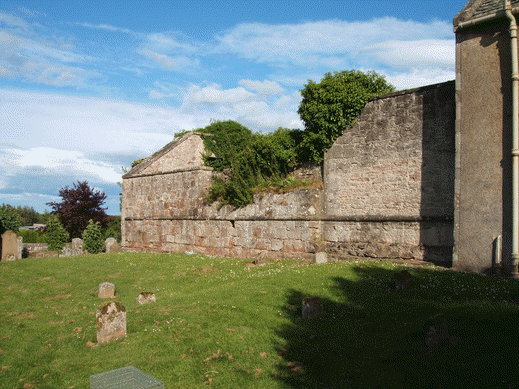
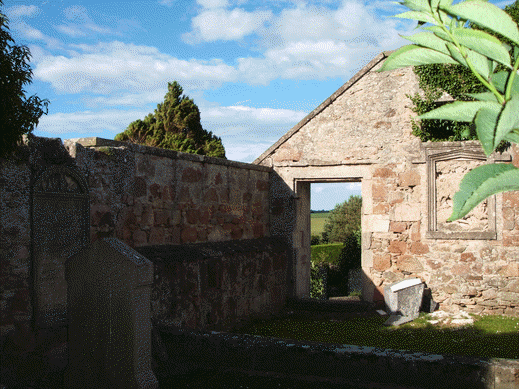
Above: Exterior and interior of the Old Church of Auldearn.
From the earliest days of diocesan organisation the importance of this church was recognised by the fact that it was established by Bishop Bricius (1208-15) as the prebend of the Dean of the cathedral church, the official who had control over all the cathedral's affairs and who, in Chapter, 'ranked' above the bishop. This prebend was augmented with the chapel of Invererne (Invernairn, now Nairn). It is interesting to see that Nairn was still much less significant as a church than Auldearn in these early days even though the Royal Castle had been moved to Nairn. We should note, however, Tranter's comments - "recent discoveries have shown a prehistoric site at Kingstep, to the East of the town (Nairn). The 4th Century St Ninian seems to have come here and Columban missionaries, arriving in the 6th Century, are said to have found a Christian cell here already established." He does not give his 'sources' for this information.
Not only did Auldearn constitute a major part of the Dean's prebend but he also had a mansion house set within a significant estate just to the east of the township, at Penick. Separate details are given of this estate which originally, was part of the lands of the Priory of Urquhard. In 1226, however, the altarage revenues of the parish church were detached from the Dean's prebend to go towards the prebend of the newly created Sub-Dean of the cathedral.
What remains of the old church building is the burial place of generations of the family of Dunbar of Boath who were patrons of this church. Also buried within the enclosure is David (II) Dunbar of Durris or Dores, sometime Dean of Moray, and James Hay of Lochloy whose considerable estate lay between the church and the coast.
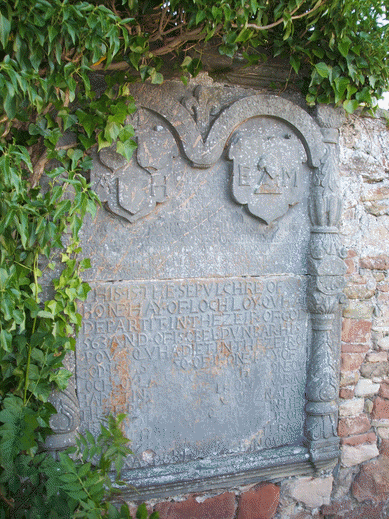
Above: A memorial tablet to John Hay of Lochloy and Park.
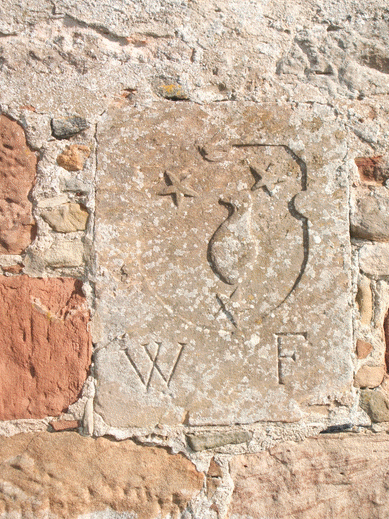
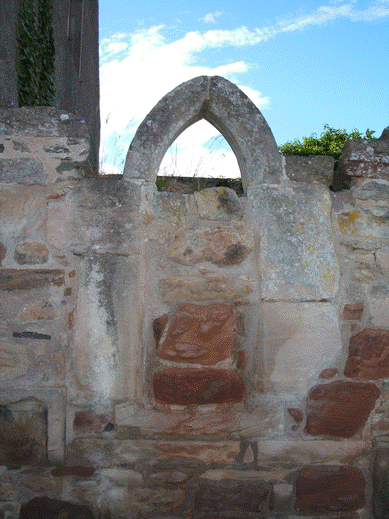
Above: An unidentified memorial and a medieval lancet window.
Three fairs were held in Auldearn each year and one of these, on 21st June, was the Festival of St Columba or "St Colm's Market."
Ross (2006) comments that, "... of the nine acres of Auldearn next to the church, one was called St Columbisaiker (St Columba's Acre), another Bellaiker (Bell Acre)."2 This latter points to land assigned to a dewar or 'keeper' of a bell-shrine or some other ancient relic of the early Christian missionaries.
Achareidh: In 1890 a portion of a slab was dug up at Achareidh {in the western part of the town of Nairn}, bearing carvings of the fretwork pattern similar to what appears in such perfection on the Rosemarkie Stone. It is a fragment of an Early Christian/Pictish class III stone bearing a key-pattern on one face is preserved at Achareidh House. [top]
Easter Clune: The site of a Catholc Chapel is still marked, and the place is known as Chaplefield. A Carved Stone, dug up during trenching operations, was taken to Nairn Museum. The site of the chapel was still marked in the Chapelfield in 1928. [top]
Foynesfield: A chapel, dedicated to St Ninian, existed at Foynesfield, and St Ninian's Well, just within the dyke of Bognafouran at the road leading to the Park, enjoyed great celebrity. [NGR NH 8952 5379]
The Chapel was known by the Gaelic form of St Ninian's name, viz., St Ringan, and the place is called "Ringan" by the Gaelic-speaking people to this day. A clump of ash trees alone remains to mark the site of the muinntir (ecclesiastical settlement).3 No definite evidence exists for the location of the pre-Reformation chapel. However, the site is reputed locally to have been on a hillock at NGR NH 892 538 where stone is still ploughed up.7
The dedication would point to this being one of the earliest Christian settlements in the north-east. [top]
Geddes: Within a short distance of Raite was the Chapel of Geddes, said to have been built in 1220 by Rose of Kilravock, whose first possession in this area was Easter Geddes. The chapel was dedicated to the Blessed Virgin Mary.
The name of Geddes is supposed to have been derived from Gildas, a British saint who lived in the 6th-century. The name is very ancient as it is found in deeds early in the 13th-century, and had then lost its original association, as is shown by its commonplace division into "Easter" and "Wester" Geddes. However, the indications point rather to there having been an early Columban cell either here (at Geddes) or at Raite, and the Celtic name of the hermit has become unrecognisable in its form of Geddes.8
The oldest extant charter of the chapel bears the date 1473, and was granted to Hugh Rose. The chapel had an endowment of £5, together with a small croft or glebe on which to erect a manse.
For some time previous to this endowment, service was performed by the vicar of the church of Dalcross, which was a living dependent on the Priory of Urquhard, and a regular agreement was entered into in 1343, between the Prior of Urquhard and the Baron of Kilravock, that the vicar should officiate on certain conditions specified.
This arrangement does not appear to have been successful, as the Papal interest had to be enlisted on behalf of the chapel, and Pope Sixtus IV, in the year 1475, issued a bull granting a discharge of 100 days' penance to all who visited the chapel on specific festival days, and gave donations of a certain amount for the good of the Chapel.
A fair called Geddes Market or Lady Fair was held in the burying-ground of the Chapel around 5th April every year. [top]
Kincraggie (St Mary): John Hay of Tullybothill {Lochloy}, with the consent of Willelmi, earl of Ross, and Johannis de Haya, his son, founded a chapel at Kincraggie out of his lands of Lochloy [NGR NH 926578], the house of Wester Raite, and certain lands and pasturage. The charter is dated at Raite (Castle?) 3 May 1374. There is no "Kincraggie" in Nairnshire, but Craggie [NGR NH 909537] was a well-known possession which lay adjacent to and was generally included in the estates of Knockdouie and Park [NGR NH 901534], which belonged to the Hays of Lochloy and Tullybothil from a very early date. On old maps it is named Knockowdie4.
The site of the chapel was in all probability at the high ground where the streamlet known as the Craggie Burn takes its rise [NGR NH 901534]. The chapel was dedicated to St Mary, and the priest's duty was to say masses for the soul of Sir John himself, and the souls of his ancestors and successors. Sir John Hay was Sheriff of Inverness when he made this grant.
He granted an annuity of four pounds usual money out of the lands of Lochloy, the one half to be paid at the Feast of Pentecost and the other at Martinmas, with two acres of land and the mansion in the town of Wester Rait, and also pasture in the same town for twelve cows and a bull, sixty sheep, and liberty of pasturing two horses on the common pasturage - no doubt the common on the Hill of Ord adjacent.4 [top]
Lethen: References are made to a chapel at Lethen but, to-date, nothing has been discovered about it. HES "Canmore" database confirms this and gives an approximate location only.[NGR NH 93_51_]
Lochloy: "There are the remains of a little chapel or oratory at Lochloy."3 "The site of a small chapel occurs near Lochloy, on the carse land, within a short distance of the western end of Lochloy. It bears marks of such extreme primitiveness that it may possibly be an early Columban chapel. The mound upon which it was built was also used as a burying place. The foundations of the wall, as far as can be seen, are built of dry-stone, and the headstones are undressed and unmarked. The well close by is known as the Chapel Well or Priest's Well [NGR NH 9226 5786], but the name of the saint to which it was doubtless dedicated is lost. The circumstances that the villagers of Lochloy and the fishers of Mavistown [NGR NH c.930598] had their burial places in more recent times at Auldearn favours its remote antiquity. It existence had been almost forgotten until on forming the road down to the Loch (Loy), fragments of human bones were disclosed, and the proprietor stopped further interference with it."9 The daughter of said "proprietor", Miss E Baillie, recorded that the discovery was made by workers of the North of Scotland Hydro Electric Board on 1 September 1959. The remains were later identified as the burials of five adults and a child and, in 1967 a possible hut-circle, midden material and a small fragment of wall were also found. She identified the site of the chapel and burying-place, and the Chapel Well, were pointed out by her and recorded.
Loch Loy and the Cran Loch are remnants of an arm of the sea which used to intrude here but which has, over the years been cut off by sand dunes blown over in successive gales. Indeed, as early as 1196, we find records that there was even a harbour here called the Port of Lochloy, which allowed sea-going ships to beach themselves on the sands and unload cargo.[top]
Moyness Castle: The Castle of Moyness also had a private chapel.3 [top]
Nairn (Holy Rood): The Holy Rood kirk of Nairn, which stood near the old Constabulary garden (79 High Street), had an altarage to St Modan, with a small endowment.6 I believe that this is the church/chapel of Invererne which is to be found occasionally in charter evidence.[top]
Rait Castle: In a charter of William the Lion to Richard, bishop of Moray - in which the king granted him the church of Auldearn with the chapel of Nairn - the Chapel of Rait is included, and it is mentioned in a subsequent charter of William's, along with the Chapel of Moyness.
It is incidentally mentioned in a Kilravock charter that the chapel of Raite was called the Hermit's Chapel, though it was re-dedicated to the B.V.M.5 [top]
Clergy:
1213 Ada was vicar of Auldearn [Reg. Ep. Mor., no.54, p.62]
1228 William Prat was vicar of Inuernarn [Reg. Ep. Mor., no.109, p.122]
1238 William was Canon of Erryn (Auldearn) [Reg. Ep. Mor., no.90, p.103]
1. Registrum Ep. Moraviensis, no.69, p.73 and no.81, p.90; Cowan, Parishes, 8, 44.
2. Ross, A.D. Unpublished PhD Thesis submitted to Aberdeen University 2006. vol.i., p.55.
3. Bain, G. (1928) History of Nairnshire. Nairn: Telegraph Office. p.94
4. ibid., p.97.; Registrum Ep. Moraviensis, no.245, p.320; no.246, p.321.
5. ibid., p.98.
6. ibid., p.104.
7. RCAHMS 1978, visited May 1978.
8. Bain (1928), p.99.
9. ibid., p.30.
e-mail: admin@cushnieent.com
© 2019 Cushnie Enterprises
